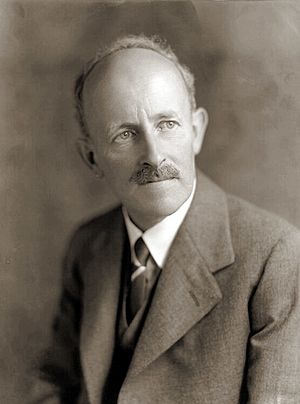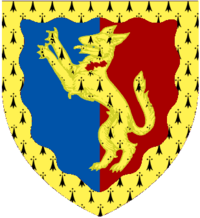Maurice Hankey, 1st Baron Hankey facts for kids
Quick facts for kids
The Lord Hankey
|
|
|---|---|
 |
|
| Cabinet Secretary | |
| In office 1916 – August 1938 |
|
| Prime Minister | |
| Preceded by | Inaugural holder |
| Succeeded by | Sir Edward Bridges |
| Chancellor of the Duchy of Lancaster | |
| In office 14 May 1940 – 20 July 1941 |
|
| Prime Minister | Winston Churchill |
| Preceded by | The Lord Tryon |
| Succeeded by | Duff Cooper |
| Personal details | |
| Born | 1 April 1877 Biarritz, France |
| Died | 26 January 1963 (aged 85) Redhill, Surrey, England |
Maurice Pascal Alers Hankey (born April 1, 1877 – died January 26, 1963) was a very important British government official. He became famous as the first-ever Cabinet Secretary. This job meant he was the top helper for the Prime Minister and the government's main team. Later, he even became a government minister himself, which was quite rare for someone who started as a civil servant. He is best known for being a super-efficient assistant to Prime Minister David Lloyd George during World War I. He helped lead Britain through that tough time.
Contents
Personal Life and Family
Maurice Hankey was born in Biarritz, France, in 1877. He was the third son of R. A. Hankey. He went to Rugby School for his education. After school, he joined the Royal Marine Artillery. He became a captain. He worked in different roles, including helping to analyze coastal defenses.
His youngest brother, Donald Hankey, was a soldier. Donald was known for essays he wrote while fighting in World War I on the Western Front. Sadly, Donald died in battle during the Battle of the Somme.
Around Christmas in 1902, Maurice met Adeline de Smidt. They got married in September 1903. They had a very strong and supportive relationship. Adeline often went with him to important social events. She also joined him at big meetings like the Paris Peace Conference.
Maurice and Adeline had four children: Robert (born 1905), Ursula (born 1909), Christopher (born 1911), and Henry (born 1914). Their family moved a few times when the children were young. They lived in Malta for a year in 1907. Eventually, they settled in Highstead near Limpsfield, Surrey.
Lord Hankey passed away in 1963 when he was 85 years old. His oldest son, Robert, took over his title as Baron Hankey.
Career in Government Service
In 1908, Maurice Hankey got a job as Naval Assistant Secretary. This was for the Committee of Imperial Defence. He became the Secretary of this Committee in 1912. He held this important position for 26 years.
In November 1914, he also became the Secretary of the War Council. In this role, he noticed ideas from Major Ernest Swinton. These ideas were about building a tracked armored vehicle. Hankey shared these ideas with Winston Churchill on December 25, 1914. This led to the creation of the Landship Committee, which helped develop the first tanks.
In December 1916, David Lloyd George became the Prime Minister. He changed how the government worked. A small group called the War Cabinet was created. Hankey was made its Secretary. He also served as Secretary of the Imperial War Cabinet. This group included leaders from Britain's colonies and other countries.
Hankey became known for being very good at his job. When the full Cabinet was brought back in 1919, his special office was kept. He then served as Secretary to the Cabinet for 19 years. In 1923, he also became the Clerk of the Privy Council. During his long career, he often helped as the British Secretary for many international meetings. He was also Secretary-General for many Imperial Conferences.
In August 1938, Hankey retired from his main government job. He became a British Government Director for the Suez Canal Company for one year. Even after retiring, he was still a respected figure. Ministers and other officials often asked him for advice.
In August 1939, he advised Neville Chamberlain about forming a new War Cabinet. The next month, he became a Minister without Portfolio. This meant he was a minister without a specific department. He also joined the War Cabinet. Hankey was not eager to take on this role but agreed to help.
When Winston Churchill became Prime Minister in May 1940, Hankey became Chancellor of the Duchy of Lancaster. However, he was not part of Churchill's main War Cabinet. In July 1941, Lord Hankey moved to the position of Paymaster General. But the next year, he left the government completely. He continued to hold other jobs in both public and private areas until he passed away.
Post-War Activities and Writings
After World War II, Lord Hankey kept a series of very detailed handwritten diaries. He wrote in them throughout most of his years in government. This included his time as Secretary to the War Council and Imperial War Cabinet during the First World War. These diaries are now kept at the Churchill Archives Centre in Cambridge, England. Anyone can read them there.
Honours and Awards
Maurice Hankey received many important honours during his life. In 1912, he was made a Companion of the Order of the Bath. He was promoted within this order to Knight Commander in 1916. Then, in 1919, he became a Knight Grand Cross.
In 1929, Sir Maurice was made a Knight Grand Cross of the Order of St Michael and St George. In 1934, he was appointed a Knight Grand Cross of the Royal Victorian Order.
In 1939, he was given the title of Baron Hankey, of The Chart in the County of Surrey. This meant he became a Lord. The same year, he also joined the Privy Council. In 1942, he was chosen to be a Fellow of the Royal Society. This honour is given to people who have helped science a lot.
|



